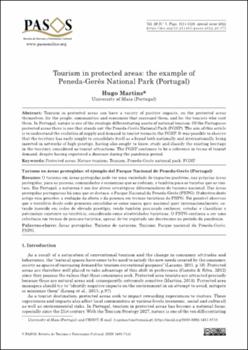Tourism in protected areas: the example of Peneda‑Gerês National Park (Portugal)
Autor
Martins, HugoFecha
2022Resumen
O turismo em áreas protegidas pode ter uma variedade de impactos positivos, nas próprias áreas
protegidas, para as pessoas, comunidades e economias que as rodeiam, e também para os turistas que as visitam.
Em Portugal, a natureza é um dos ativos estratégicos diferenciadores do turismo nacional. Das áreas
protegidas portuguesas há uma que se destaca: o Parque Nacional da Peneda‑Gerês
(PNPG). O objetivo deste
artigo visa perceber a evolução da oferta e da procura em termos turísticos do PNPG. Foi possível observar
que o território desde cedo procurou consolidar‑se
como marca quer nacional quer internacionalmente, estando
inserido em redes de elevado prestígio, tendo também procurado conhecer, estudar e classificar o
património existente no território, considerado como atratividades turísticas. O PNPG continua a ser uma
referência em termos de procura turística, apesar de ter registado um decréscimo no período da pandemia. Tourism in protected areas can have a variety of positive impacts, on the protected areas
themselves, for the people, communities and economies that surround them, and for the tourists who visit
them. In Portugal, nature is one of the strategic differentiating assets of national tourism. Of the Portuguese
protected areas there is one that stands out: the Peneda‑Gerês
National Park (PGNP). The aim of this article
is to understand the evolution of supply and demand in tourist terms in the PGNP. It was possible to observe
that the territory has early sought to consolidate itself as a brand both nationally and internationally, being
inserted in networks of high prestige, having also sought to know, study and classify the existing heritage
in the territory, considered as tourist attractions. The PGNP continues to be a reference in terms of tourist
demand, despite having registered a decrease during the pandemic period.





